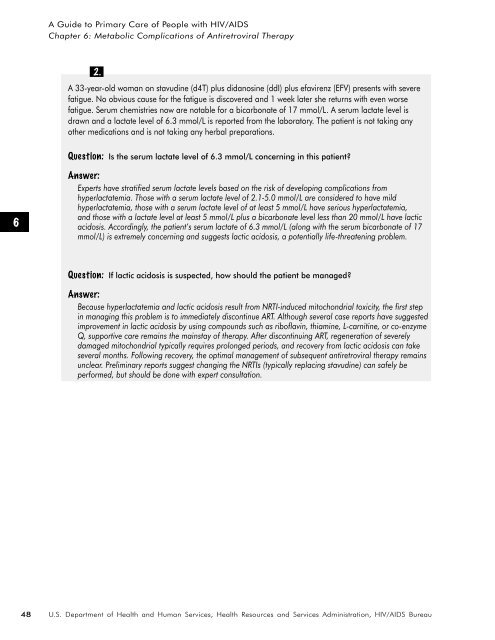A Guide to Primary Care of People with HIV/AIDS - Canadian Public ...
A Guide to Primary Care of People with HIV/AIDS - Canadian Public ...
A Guide to Primary Care of People with HIV/AIDS - Canadian Public ...
Create successful ePaper yourself
Turn your PDF publications into a flip-book with our unique Google optimized e-Paper software.
A <strong>Guide</strong> <strong>to</strong> <strong>Primary</strong> <strong>Care</strong> <strong>of</strong> <strong>People</strong> <strong>with</strong> <strong>HIV</strong>/<strong>AIDS</strong><br />
Chapter 6: Metabolic Complications <strong>of</strong> Antiretroviral Therapy<br />
2.<br />
A 33-year-old woman on stavudine (d4T) plus didanosine (ddI) plus efavirenz (EFV) presents <strong>with</strong> severe<br />
fatigue. No obvious cause for the fatigue is discovered and 1 week later she returns <strong>with</strong> even worse<br />
fatigue. Serum chemistries now are notable for a bicarbonate <strong>of</strong> 17 mmol/L. A serum lactate level is<br />
drawn and a lactate level <strong>of</strong> 6.3 mmol/L is reported from the labora<strong>to</strong>ry. The patient is not taking any<br />
other medications and is not taking any herbal preparations.<br />
Question: Is the serum lactate level <strong>of</strong> 6.3 mmol/L concerning in this patient?<br />
6<br />
Answer:<br />
Experts have stratified serum lactate levels based on the risk <strong>of</strong> developing complications from<br />
hyperlactatemia. Those <strong>with</strong> a serum lactate level <strong>of</strong> 2.1-5.0 mmol/L are considered <strong>to</strong> have mild<br />
hyperlactatemia, those <strong>with</strong> a serum lactate level <strong>of</strong> at least 5 mmol/L have serious hyperlactatemia,<br />
and those <strong>with</strong> a lactate level at least 5 mmol/L plus a bicarbonate level less than 20 mmol/L have lactic<br />
acidosis. Accordingly, the patient’s serum lactate <strong>of</strong> 6.3 mmol/L (along <strong>with</strong> the serum bicarbonate <strong>of</strong> 17<br />
mmol/L) is extremely concerning and suggests lactic acidosis, a potentially life-threatening problem.<br />
Question: If lactic acidosis is suspected, how should the patient be managed?<br />
Answer:<br />
Because hyperlactatemia and lactic acidosis result from NRTI-induced mi<strong>to</strong>chondrial <strong>to</strong>xicity, the first step<br />
in managing this problem is <strong>to</strong> immediately discontinue ART. Although several case reports have suggested<br />
improvement in lactic acidosis by using compounds such as rib<strong>of</strong>lavin, thiamine, L-carnitine, or co-enzyme<br />
Q, supportive care remains the mainstay <strong>of</strong> therapy. After discontinuing ART, regeneration <strong>of</strong> severely<br />
damaged mi<strong>to</strong>chondrial typically requires prolonged periods, and recovery from lactic acidosis can take<br />
several months. Following recovery, the optimal management <strong>of</strong> subsequent antiretroviral therapy remains<br />
unclear. Preliminary reports suggest changing the NRTIs (typically replacing stavudine) can safely be<br />
performed, but should be done <strong>with</strong> expert consultation.<br />
48<br />
U.S. Department <strong>of</strong> Health and Human Services, Health Resources and Services Administration, <strong>HIV</strong>/<strong>AIDS</strong> Bureau

















